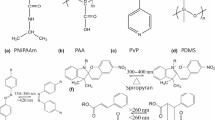Abstract
This paper describes a method to increase the aspect ratio of polymeric pillar arrays formed by electrohydrodynamic instabilities. Pillar arrays form spontaneously across a narrow capacitor gap when an electric field is applied normal to a thin, fluidic film. This simple technique is appealing because of its ability to rapidly form arrays of small structures in an inexpensive manner. The columnar structures formed using this technique have low-aspect ratios, which are non-ideal for patterning applications. Theory suggests that stretching the structures post-formation is one of the only ways to increase the aspect ratio of the pillars. We developed a tool to physically stretch these structures to increase their aspect ratio from ∼0.1 to ∼0.5. The capabilities and limits of this stretching technique have been discussed.








Similar content being viewed by others
References
Schaffer E, Thurn-Albrecht T, Russell TP, Steiner U (2000) Nature (London) 403(6772):874
Chou SY, Zhuang L (1999) J Vac Sci Technol B 17(6):3197
Schaffer E, Thurn-Albrecht T, Russell TP, Steiner U (2001) Europhys Lett 53(4):518
Pease LF III, Russel WB (2004) Langmuir 20(3):795
Dickey MD, Collister E, Raines A, Tsiartas P, Holcombe T, Sreenivasan SV, Bonnecaze RT, Willson CG (2006) Chem Mater 18(8):2043
Herminghaus S (1999) Phys Rev Lett 83(12):2359
Pease LF, Russel WB (2003) J Chem Phys 118(8):3790
Lin Z, Kerle T, Russell TP, Schaeffer E, Steiner U (2002) Macromolecules 35(10):3971
Pease LF, Russel WB (2002) J Non-Newtonian Fluid Mech 102(2):233
Verma R, Sharma A, Kargupta K, Bhaumik J (2005) Langmuir 21(8):3710
Lin Z, Kerle T, Baker SM, Hoagland DA, Schaffer E, Steiner U, Russell TP (2001) J Chem Phys 114(5):2377
Erle MA, Gillette RD, Dyson DC (1970) Chem Eng J 1(1):97
Plateau J (1873) Experimentale et Theoretique des Liquides
Rayleigh L (1879) Proc R S Lond 29:71
Myshkis AD (1987) Low-gravity fluid mechanics: mathematical theory of capillary phenomena. Springer-Verlag, Berlin, New York, pp xix, 583
Slobozhanin LA, Perales JM (1993) Phys Fluids A: Fluid Dyn 5(6):1305
Slobozhanin LA, Alexander JID, Resnick AH (1997) Phys Fluids 9(7):1893
Ramos A, Gonzalez H, Castellanos A (1994) Phys Fluids 6(11):3580
Sankaran S, Saville DA (1993) Phys Fluids A: Fluid Dyn 5(4):1081
Klingner A, Buehrle J, Mugele F (2004) Langmuir 20(16):6770
Acknowledgements
The authors thank the Advanced Materials Research Center, the NSF and Intel for graduate fellowships, and the University of Texas CNM for use of the evaporator used to deposit ITO.
Author information
Authors and Affiliations
Corresponding author
Rights and permissions
About this article
Cite this article
Dickey, M.D., Raines, A., Collister, E. et al. High-aspect ratio polymeric pillar arrays formed via electrohydrodynamic patterning. J Mater Sci 43, 117–122 (2008). https://doi.org/10.1007/s10853-007-2086-8
Received:
Accepted:
Published:
Issue Date:
DOI: https://doi.org/10.1007/s10853-007-2086-8




